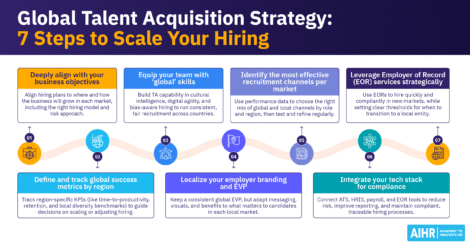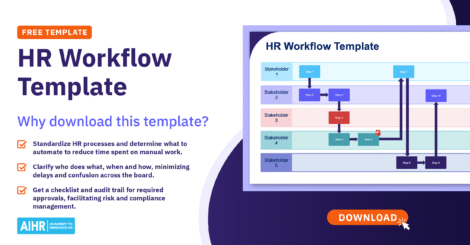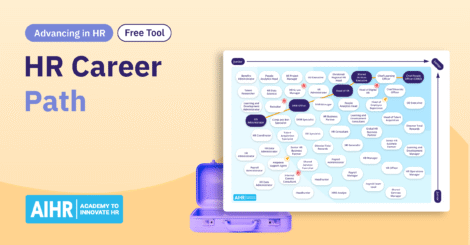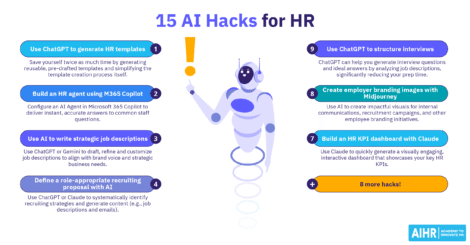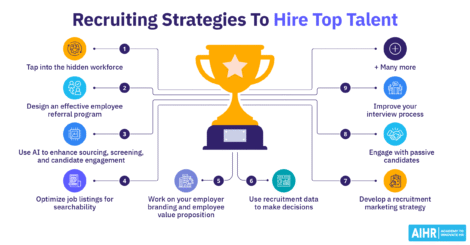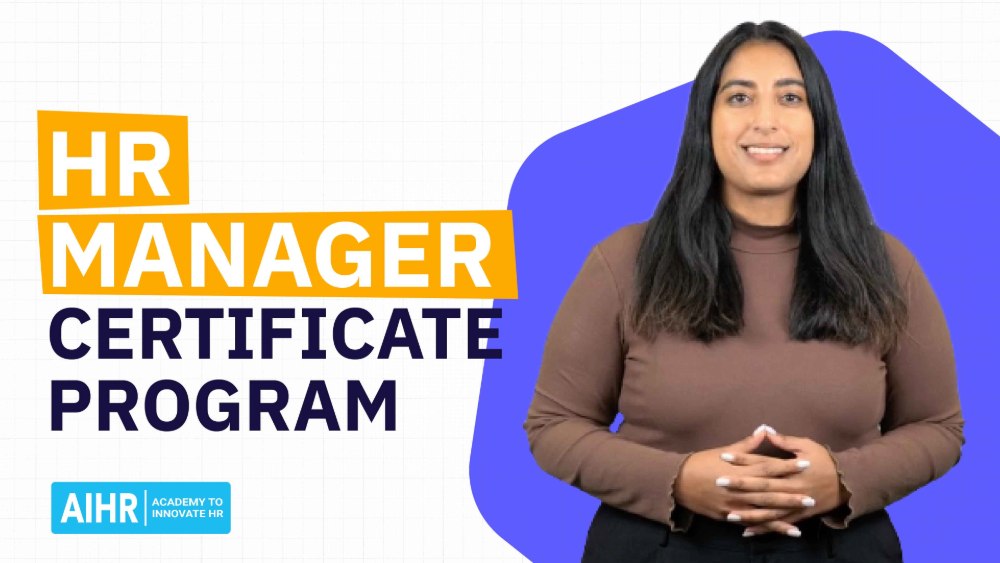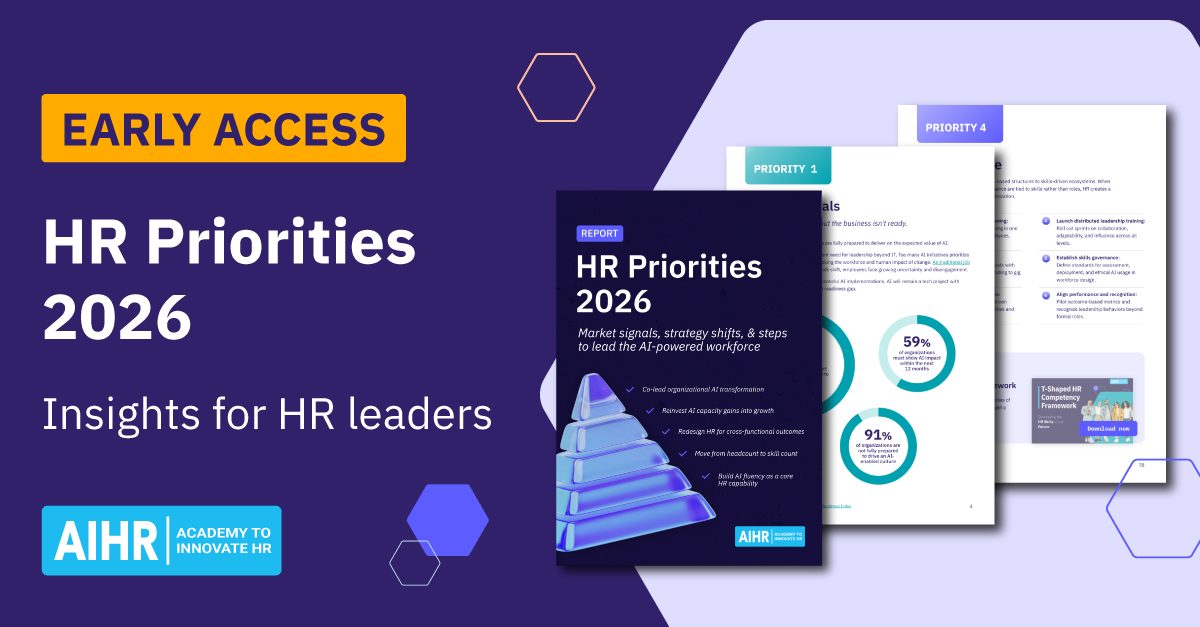The HR life cycle encompasses every activity HR carries out, from strategy to organizational design to onboarding and offboarding employees and everything in between.
In this guide, we’ll break down what the HR life cycle is, how it’s different from the employee life cycle, and why that distinction matters. We’ll also walk through all 13 stages of the HR life cycle. To help you put it into practice, we’ve included a practical toolkit with templates HR leaders can reuse to build and improve their HR processes.
Contents
What is the HR life cycle?
Why strategic HR starts with a well-integrated HR life cycle
13 steps in the HR life cycle process
Free HR life cycle toolkit for HR leaders
FAQ
What is the HR life cycle?
The HR life cycle—also known as the HR cycle—is a framework for creating a streamlined and impactful HR function. It covers all HR activities and how they work within an organization, starting with business strategy and ending with an employee’s exit.
In other words, the HR life cycle integrates the creation and execution of HR strategies with the employee life cycle. While these two terms are often used interchangeably, they are not the same. The employee life cycle focuses solely on the stages of an individual’s journey with an employer, from attraction through to exit. The HR life cycle goes broader, tying individual experiences to organizational-level strategy and operations.
This process is continuous. Changes in the workforce, such as employee turnover, skill development, and performance, along with shifts in company makeup like culture, organizational structure, and team design, all influence the business strategy. In turn, that strategy is built on the company’s strengths, which its people and structure directly shape. This ongoing interaction is what makes the model cyclical.
The HR life cycle includes both vertical integration (business strategy informing HR strategy and practices) and horizontal integration (alignment among HR practices themselves).
With rapid advancements in technology and the adoption of AI, the way tasks and processes are carried out in the HR life cycle is changing, with an increasing number of repeatable and administrative managerial tasks being automated. It’s essential that HR leaders understand how this life cycle plays out in their company to be able to keep their function as effective as possible.

Why strategic HR starts with a well-integrated HR life cycle
HR leaders should prioritize understanding the HR life cycle and integrating it into their organization for many reasons.
- It bridges strategy and execution: An effective HR life cycle ensures all HR activities align with the business’s overall strategy and facilitate a positive employee experience.
- It exposes gaps and silos: A structured examination of the 13 steps of the HR life cycle can show you where your HR function’s strengths and weaknesses are, including any gaps and silos, enabling you to bridge these.
- It improves stakeholder alignment: An integrated HR life cycle gives HR leaders a clearer way to communicate priorities, plans, and trade-offs with business leaders. It makes it easier to explain how HR initiatives connect to broader goals, which builds trust, sets expectations, and helps secure buy-in from key stakeholders across the organization.
- It enables smarter, long-term planning: Through understanding the organizational strategy, HR leaders are better prepared for HR planning and can pinpoint the strategic priorities for HR.
13 steps in the HR life cycle process
The HR life cycle encompasses 13 steps. Let’s explore them in detail and look at how they integrate with each other.
To make this practical, we’re also including an illustrative example that showcases how the HR life cycle could work within an organization. Our example is a company called “Crafted Coffee Co.”
- Industry: Specialty coffee roasting and retail
- Size: 400 employees
- Offices: Head office + 2 roasting facilities + 50 café locations across 6 states
- Current strategic priority: Scale operations, boost digital sales, and reduce barista turnover.
1. Business strategy
Any HR activity should start with the organization’s business strategy. Common frameworks for defining this strategy are the SWOT analysis, Porter’s Five Forces analysis, and the more contemporary business model canvas.
The business strategy translates to several strategic priorities, which are then translated into the HR strategy. A well-defined business strategy can be translated into an effective HR strategy.
Example: Crafted Coffee aims to double its e-commerce sales in two years and reduce café staff turnover from 35% to 20%. Its SWOT analysis identified high product loyalty and employee churn as top strengths and weaknesses.
2. HR strategy
In this stage, the business strategy is translated into the people strategy. HR may use tools similar to those used in the previous step to define its priorities and direction. The goal is clear: the HR strategy should align with business objectives so that every HR activity contributes directly to achieving them.
Example: To align with business goals, the HR team at Crafted Coffee prioritizes:
- Building an internal learning platform for baristas and café leads
- Employer branding to attract purpose-driven talent
- A robust internal mobility program to grow from within.
3. Organizational design
The organizational strategy and HR strategy then need to be translated into an optimal organizational design that helps the business reach its goals and succeed.
This can happen in multiple ways. The most straightforward route is to use the company’s mission, goals, and competitive strategies to define organizational design criteria, which are then used to draw the actual design.
Example: Based on the goals of the company, the organizational design for Crafted Coffee will be:
- Designed for flexibility, allowing the company to scale operations
- A geography-based organizational design that clusters all the cafes in each state into a division, which is overseen by a team of managers, with the head office as its own division
- Empowering the roasting facility managers to approve supply changes instead of waiting for C-level approval, thereby reducing delays and improving sales.
From designing strategy to delivering initiatives and measuring impact, the HR life cycle requires a multitude of skills your HR team needs to excel at.
AIHR for Business helps you empower your HR team to:
✅ Translate business needs into HR strategies that drive results
✅ Design effective initiatives and processes across key HR domains
✅ Evaluate and optimize HR’s impact through data and continuous improvement.
🎯 Strengthen your entire HR life cycle with a team ready to deliver at every step.
4. Job & team design
Once the organizational structure is in place, the next step is to design jobs and teams. Job design involves creating roles that support organizational goals while also being motivating and meaningful for employees. This process typically involves job analysis, a competency analysis, and the (re)designing of the job.
Team design builds on this foundation by forming groups that can work together effectively within the organizational framework. Well-structured teams enable functional units to operate smoothly, contributing to the overall success of the strategy.
Example:
- A job analysis at Crafted Coffee Co. reveals that high barista turnover is largely due to insufficient training. In response, HR introduces a stronger onboarding program and pairs each new hire with a “buddy” for their first six weeks to provide hands-on support.
- At the team level, cafés are restructured to have more staff per shift to reduce workload. A new supervisor role is added between baristas and café managers, creating a more accessible point of contact for day-to-day support.
5. HR planning
HR planning focuses on forecasting both the demand for and supply of talent. Demand is shaped by the organizational strategy, technological investments, and future workforce needs in terms of size and skill set.
Supply, on the other hand, depends on internal talent pools, external labor market conditions, retention capacity, and the characteristics of the current workforce.
Based on this analysis, HR develops a personnel action plan. This may include recruitment, internal mobility, reskilling efforts, automation initiatives, or, in some cases, measures like hiring freezes, early retirement options, or severance programs.
Example:
- At Crafted Coffee Co., high barista turnover has created workforce instability, and talent demand is expected to rise as the company grows
- To support digital sales expansion, AI tools are adopted to automate tasks, improve personalization, and enhance forecasting through data insights
- HR analytics identifies a potential leadership gap at the head office, prompting the development of succession plans.
- Baristas are offered clear career paths and growth opportunities to boost engagement, job satisfaction, and retention.

6. Vision and culture
Once jobs and teams are in place, the focus turns to culture building. A strong organizational culture starts with a clear vision — what the company stands for and the direction it’s heading. Culture is how that vision is lived out day to day.
Cultural values shape how people work and interact. Netflix is a well-known example, having built a culture around what it calls “actual values” rather than aspirational ones. One such value is to “Hire, Reward, and Tolerate Only Fully Formed Adults,” which encourages employees to rely on logic and judgment rather than rigid rules.
Culture isn’t something you set once; it needs consistent reinforcement. It also gives managers a framework for addressing behavior that doesn’t align with company values.
As Peter Drucker famously said, “Culture eats strategy for breakfast.” In other words, even the best plans won’t succeed without a culture that supports them.
Example:
- Crafted Coffee Co.’s vision is to become the leading specialty coffee roasting and retail brand in the U.S., offering only ethically and sustainably sourced coffee.
- To support that vision, HR fosters a culture where employees are encouraged to excel in their roles while staying true to the company’s ethical and sustainability standards.
7. Recruitment & selection
In the HR life cycle model, this is where the employee life cycle begins. Recruitment and selection focus on attracting and choosing the right people for your organization.
The goal at this stage is to bring in candidates who not only have the necessary skills and experience but also align with your company’s values and culture.
Typical HR efforts at this stage are employer branding, the selection process, assessments, and talent acquisition strategies.
Example:
- To reduce barista turnover at Crafted Coffee Co., the talent acquisition team creates a more robust recruitment journey, using personality questionnaires and skills assessments to find candidates who are team players, passionate about delivering excellent service, and able to perform under pressure in a busy environment.
- To support digital growth, the company hires a new head of marketing from a competitor.
- To improve its employer brand, Crafted Coffee updates its website and careers page to highlight its ethical and sustainable practices.
8. Onboarding and induction
Employee induction centers on bringing employees up to speed and giving them all the information and tools they need to perform in their job.
Similarly, employee onboarding is an employee’s introduction to and assimilation into an organization. This is the journey from when the employee signs a contract of employment through to them reaching optimum productivity levels. At this point, the employee is fully onboarded and at 100% productivity. This typically takes three to nine months, depending on the complexity of the job.
Example:
- At Crafted Coffee Co., all new baristas are enrolled in an online training program as soon as they accept their offer. The course covers company values and service standards and must be completed before their first day.
- On day one, each new hire is paired with a “buddy” who provides on-the-job guidance during their first six weeks.
- In addition, baristas have monthly informal check-ins with their supervisors for the first three months to review progress, identify training needs, and resolve any early challenges.
9. Assessment and appraisal
In this stage of the Human Resources life cycle, performance management is the focus. Managers evaluate employees, provide feedback, and help align individual goals with broader business objectives.
The cycle involves setting clear goals, tracking progress, and taking action based on outcomes. If goals aren’t met or new skills are needed, employees work with their managers to create development plans. When goals are achieved, strong performance is recognized and rewarded.
Example:
- At Crafted Coffee Co., all baristas participate in a performance management program that includes quarterly review meetings and clearly defined performance criteria.
- To reinforce high standards, the barista at each café who receives the best customer service feedback each month is awarded a $100 bonus.
10. Training & development
This stage focuses on developing employees to help them perform better in their current roles, prepare for future opportunities, or adapt to evolving skill requirements. This includes upskilling, reskilling, and role-specific learning.
Learning refers to gaining the knowledge, skills, and behaviors needed to improve job performance. It often happens through seminars, hands-on practice, or self-guided learning. Development supports long-term growth and is usually facilitated through coaching, mentoring, or challenging assignments that build broader capabilities.
Example:
- Crafted Coffee Co. creates a mock café in each state to deliver a new training program for baristas. The training covers both technical skills and areas like organization and time management. It is also added to the onboarding process and completed before a barista starts their first shift.
- After one year with the company, baristas interested in leadership roles are invited to join a management training program to prepare for a potential move into a supervisor position.
11. Engagement & reward
Alongside shaping a strong culture, HR plays a key role in creating a positive employee experience and fostering engagement. These factors often matter more to employees than high pay alone, although fair and competitive compensation remains essential for long-term retention.
Example:
- At Crafted Coffee Co., the employee experience is improved by upgrading computers and till systems in all cafés, giving staff the tools they need to do their jobs effectively.
- The compensation and benefits package is also updated. Pay is brought in line with competitors, and new benefits are introduced, including a free gym membership, health insurance, and access to online therapy sessions to support overall wellbeing.
12. Career management
Career management and career pathing help employees grow professionally while showing that the organization is invested in their development.
For example, someone aiming to become a sales manager may need to move through several commercial roles. Mapping out a clear path keeps them motivated, focused, and better equipped to reach their goal.
This process also supports engagement, improves retention, and strengthens succession planning.
Example:
- At Crafted Coffee Co., all employees in both the head office and cafés have access to an AI-powered career pathing tool. The tool helps them create a personalized development plan by identifying roles that match their skills, interests, and experience. It also highlights skill gaps and offers resources to help employees grow within the company.
13. Exit
The final stage in the HR life cycle is when an employee leaves the organization.
Ideally, departing employees become advocates who speak positively about their experience and even refer future candidates or customers. On the other hand, if someone leaves feeling undervalued or mistreated, they may damage the company’s reputation. That’s why a strong employee experience throughout the earlier stages of the HR life cycle is essential—it reduces unwanted turnover and helps preserve the employer brand.
Of course, some turnover is inevitable. What matters is learning from it. By asking the right questions during the offboarding process, organizations can identify patterns and make changes to retain others.
Example:
- At Crafted Coffee Co., HR conducts a structured exit interview with every employee who gives notice. The feedback collected during these conversations is an important part of the offboarding process.
- Recurring feedback shows that baristas often leave due to feeling stressed and overwhelmed. In response, the company increases staffing levels across cafés to ease workloads and improve the day-to-day experience.
HR life cycle toolkit for HR leaders
HR leaders can make their work scalable and processes repeatable with clear templates. Below, we’ve compiled a collection of templates that HR leaders can use to strengthen the HR life cycle at their organization.

What’s in:
Anchors all HR activities to business goals and sets the direction for the entire cycle.
Helps forecast talent needs and align people planning for growth, change, or stability.
Supports clear decision-making when juggling competing HR initiatives or projects.
Clarifies ownership across cross-functional HR work and helps avoid confusion in execution.
Critical for capability building, workforce agility, and internal mobility.
Helps identify the difference between the current HR capabilities and what’s needed to meet strategic goals to plan targeted improvements.
Gives visibility into how HR is performing across the life cycle, enabling data-driven leadership.
Over to you
Integrating the HR life cycle stages in your organization will help you to align HR activities with business strategy, highlight any gaps, support cross-functional leadership, and enable smarter, long-term HR planning. The continuous cycle ensures constant monitoring and improvement at all stages, and leads to more efficient and effective HR practices that contribute to higher engagement, productivity, and retention.
FAQ
The HR life cycle encompasses all HR activities, beginning with business strategy. On the other hand, the employee life cycle focuses solely on the relationship between the employee and the organization and the stages they go through, beginning with attraction and ending with exiting the business.
Technology can help enhance the HR life cycle at all stages by streamlining processes, improving consistency, and enabling data-driven decisions across every stage. For example, AI tools can reduce repetitive, administrative tasks like scheduling interviews and approving leave and a 24/7 chatbot help desk can instantly answer any queries employees have. HR technology also helps surface insights and personalize the employee experience. For HR leaders, this means more time for strategic work and better visibility into what’s working and where to adjust.










